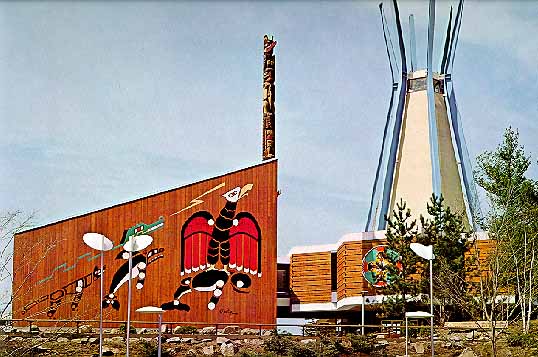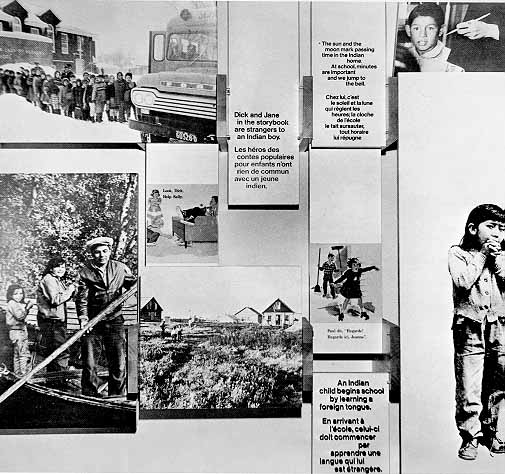Indians of Canada
Indians of Canada pavilion resembled a giant 100 foot high teepee. Inside the Indians introduced their exhibit with an accusation addressed to their countrymen. "You have stolen our native land, our culture, our soul... and yet, our traditions deserve to be appreciated, and those derived from an age-old harmony with nature even merited being adopted by you." It was a frank message and a controversial project, yet the Federal Government was commended for supporting it.
| The Indians of Canada pavilion. |
Other striking elements of the pavilion were the bold, colorful murals on the wooden walls of the building that were painted by artist Francis Kagigewikwenikong, and the tall totem pole standing near the pavilion's entrance. It was carved by British Columbia's Tony and Harry Hunt, in the Kwakiutl tradition. At the top of the 65 foot high pole was the Thunderbird-raven which, like Zeus' eagle, can order lightning to strike. Those that ventured inside, especially if they were a "paleface" were made to feel small. It was akin to running the gauntlet. The documents, drawings, works of art and photographs of contemporary conditions were accompanied by unkind comments about what the white man has done to the original Canadians.

| The world of the Paleface as seen by the bitter eye of the Indian. |
Inside the main entrance, a carved cedar figure of a superb warrior in full dress, stood guard and bid its welcome. On both sides of an inclined ramp were a portrayal of the Indians' Ancestral land. Trees, shrubs, plants and rocks symbolized the Indian's harmony with nature. Further on a mural, depicting a moose, a stag and bloody hands. The Indian said, " To still our hunger, we killed an animal, and after eating our fill, we gave thanks to the Great Spirit who had sent it to us." They also pointed out that "the great discoverers of Canada traveled in Indian canoes, wore Indian snowshoes, ate Indian food, lived in Indian cabins. Without their Indian friends, not one of them could have survived or made their travels."
As for the efforts of the efforts of the first Christian missionaries, the Indians pointed out: "Long before they came, we had already talked with God, whom we called the Great Spirit, after our fashion. We lived together as brothers and we saw the Spirit present in every living thing."
There is an exhibit devoted to education, but the photographs are ironic. The handicaps that Indian children were detailed. The child must begin at school by learning a foreign tongue, that is English or French. And generally the white man's style of education is an alien envirornment to a young Indian. With him it is the sun and the moon which regulates passing time. Any clock-regulated timetable is repugnant to him. The school bell startles him. The heroes of our schoolbooks have nothing in common with him.
Having run the gauntlet, the visitor descended from the upper exhibit level. Below was a symbolic campfire with seating all around and the message, "And now, my brother, sit down by the fire. Let us talk about the times which are coming. You have traveled over the long footpaths along which your forefathers trudged ... In a moment we shall take to the trail again. But during this stop, let us search in the flames for visions of the future..."